Bezel yet again wants to impress us with the 27HX270. A 27-inch 1440P/QHD display with with up to 165Hz of refresh rate priced at 15,999 Pesos.
Apart from the specifications above, the monitor also comes with an IPS panel with a GtG response time of 3ms. To make things even better, this is an LG IPS panel with a 10-bit color depth.
Note that 165Hz is achievable only via the DisplayPort, while HDMI could net a maximum of 144Hz. It appears that the display also supports strobing with an HDR400 certification on top of its RGB lighting capabilities.
Technical Specifications
| Display | |
| LCD Size | 27″ |
| Aspect Ratio | 16:9 |
| Resolution | 2560×1440 |
| Refresh Rate | 165Hz via DisplayPort, 144Hz via HDMI |
| Adaptive Sync | AMD FreeSync |
| Pixel Pitch | 0.2335mm |
| Brightness | 350cd/㎡ |
| Contrast Ratio | 1000:1 |
| Panel Type | IPS |
| Response Time | 1ms MPRT, 3ms GtG |
| Color Space | 100% sRGB |
| Color Depth | 10-bit |
| Backlight | LED |
| Connectivity | |
| Display Options | 2x DisplayPort 1.4, 1x HDMI 2.0 |
| USB | USB 2.0 (firmware update?) |
| Audio | 1x 3.5mm (audio-out) |
| Ergonomics | |
| VESA Mount | 100x100mm |
| Pivot | Supported by the extra stand |
| Swivel | Supported by the extra stand |
| Tilt | -5°/+20°, Supported by the extra stand |
| Lift | Supported by the extra stand |
| Dimensions | |
| Length | 610mm |
| Width | 40mm |
| Height | 368mm |
| Weight | NA |
Packaging and Accessories
Bezel packed the 27HX270 inside a simple packaging together with its standard issue stand. The extra one comes with its own box. The product should come with the following items inside:
- 2x DisplayPort cable
- Power adapter
- Power cord
- 8x Mounting screw
- Standard stand
- Ergonomic stand
Bundles are excellent except for the missing user’s manual. Bezel even threw a UGREEN DisplayPort for good measure.
Design, Layout and Build Quality
The Bezel 27HX270 is one of the many two-faced gaming displays in the market with its simple facade yet gaming oriented back-end design with RGB lighting and aggressive lines. It looks classy enough especially with the standard stand in place.
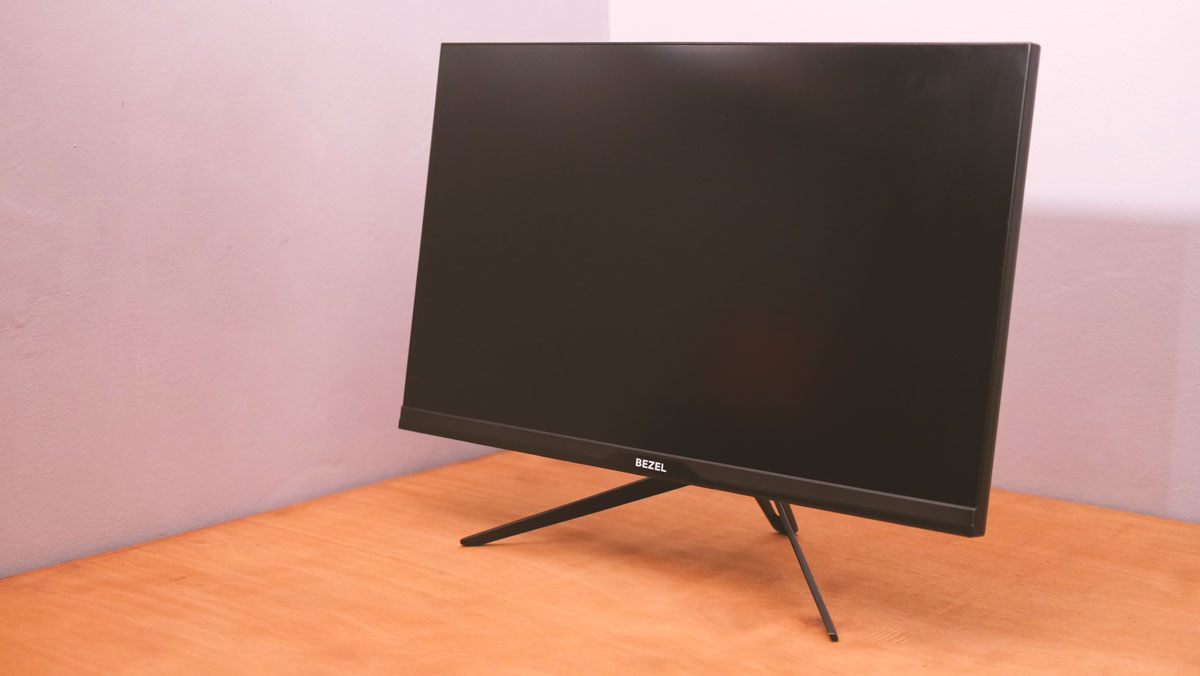
Our friends from Bezel or LG rather, opted to go with a semi-matte, semi-gloss coating for this particular display. Can’t blame everyone going this route since it reflects less compared to your usual glossy panels.
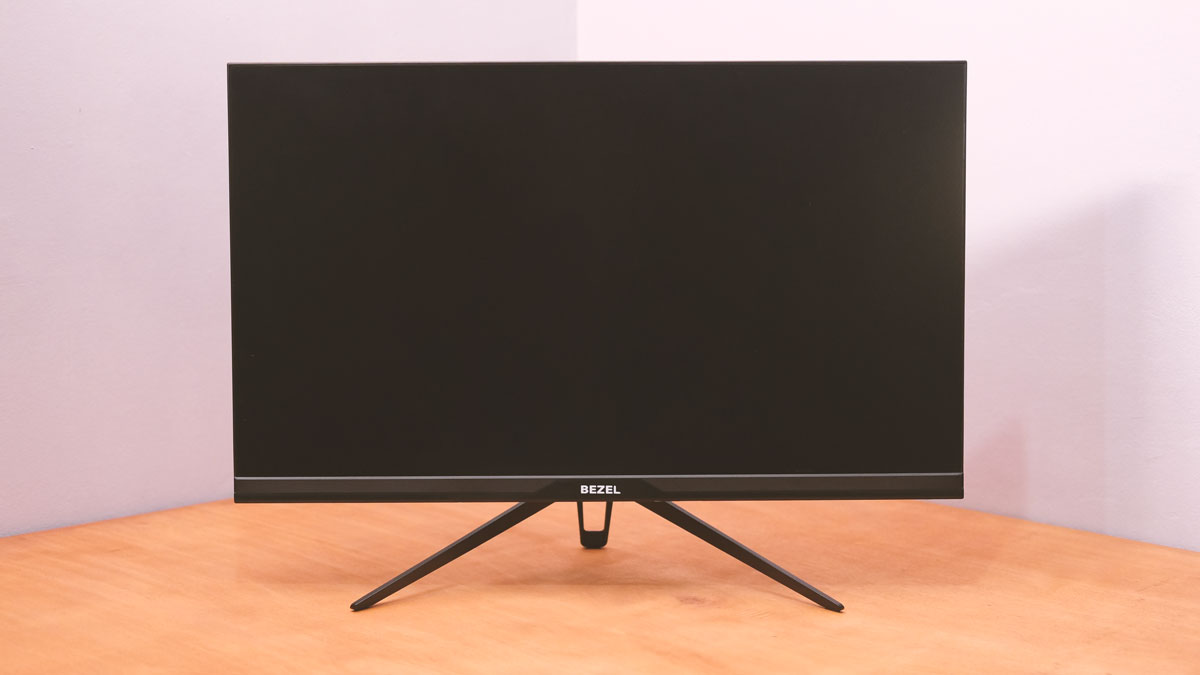
Now ergonomics is pretty much similar to the Bezel 27HX280 we reviewed prior to this one if we’re talking about the extra stand. As for the included one – which is by the way made out of solid aluminum, it is limited to tilt alone. Notice those translucent strips? RGB lighting fellas.
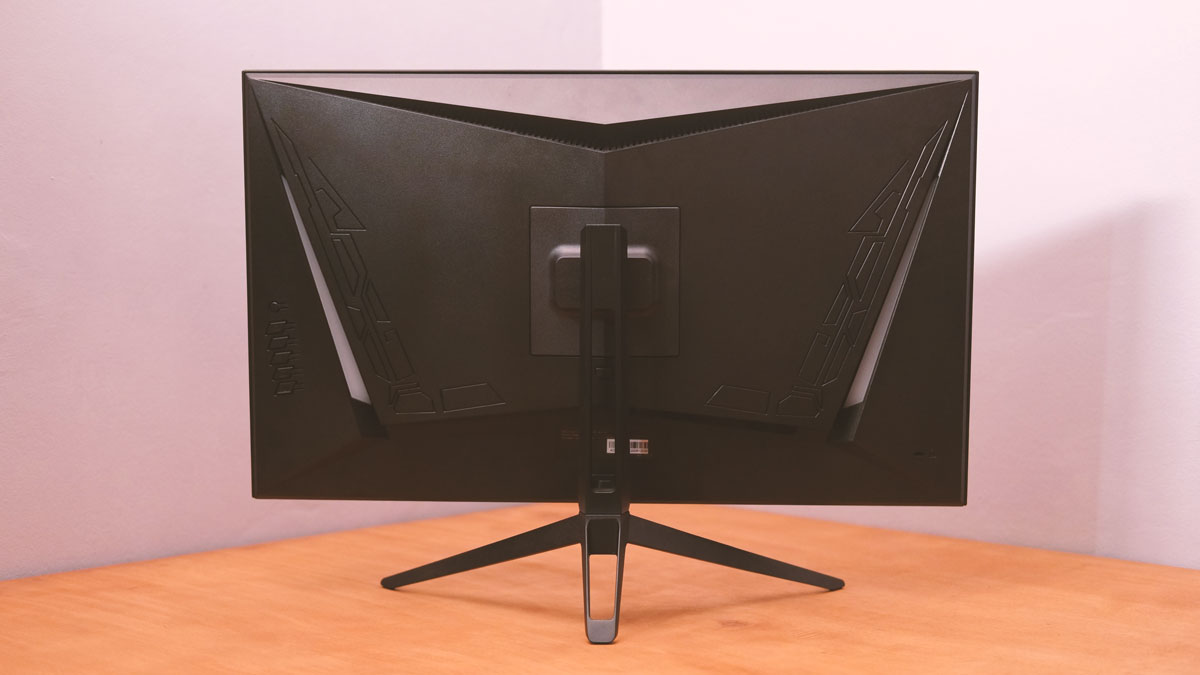
Display options are more than decent with dual HDMI and a single DisplayPort port. Audio is out, while the included USB port appears to be for firmware updates.
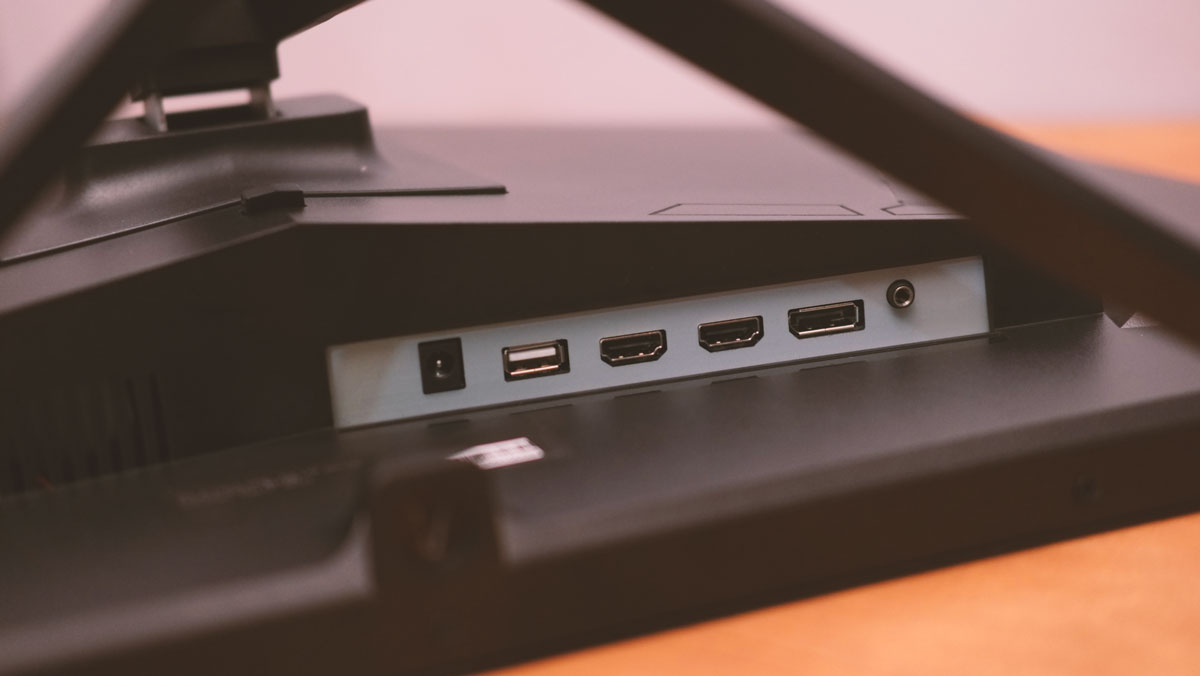
The 27HX270 doesn’t come with an onboard speaker which is a shame. Power is also external yet is less of a wall wart compared to the 27HX280’s murderous power brick.
On-Screen Display Menu
Like the 27HX280, the 27HX270’s OSD got tons of options to play with. Navigation is still a pain though like many other button based inputs. To make things even worse, the up and down buttons are swapped and some options are scattered everywhere. First up is the brightness menu which is alright.
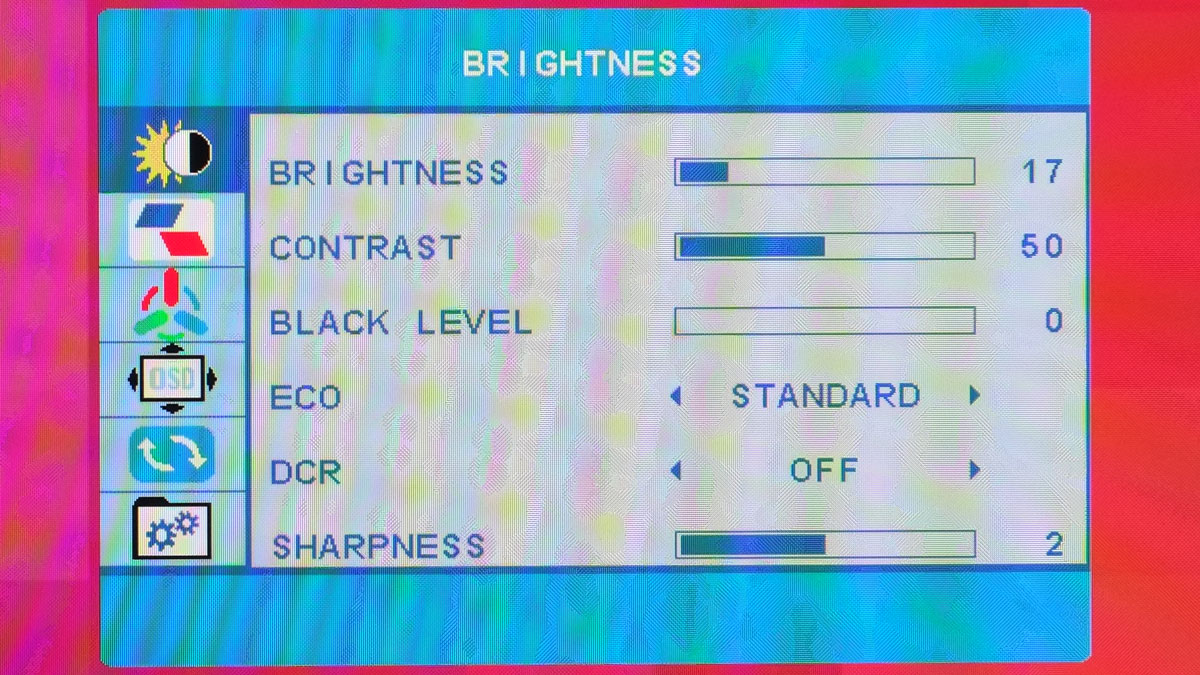
The Image menu is yet again 90% not related to what the word meant. It is funny yet surprising to see phase and clock adjustments here though.
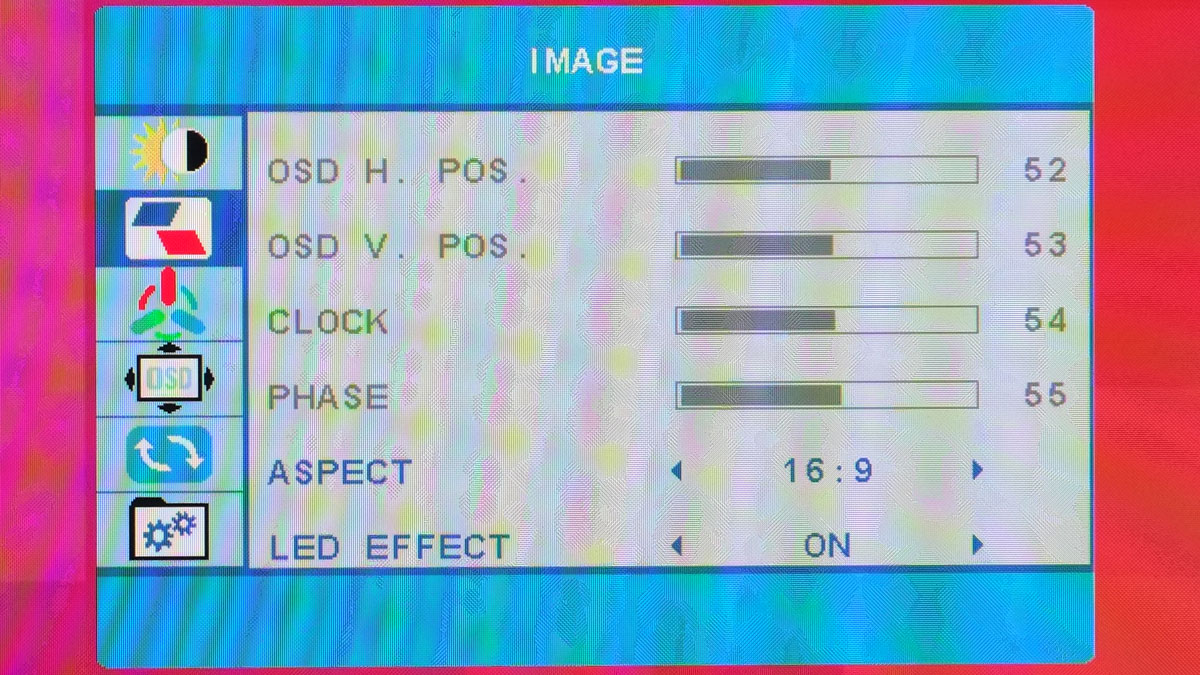
Color Temperature is next. Again, self explanatory settings. We have warm, cool and user (default) here. Defaults for each primary colors are not in percentage though.
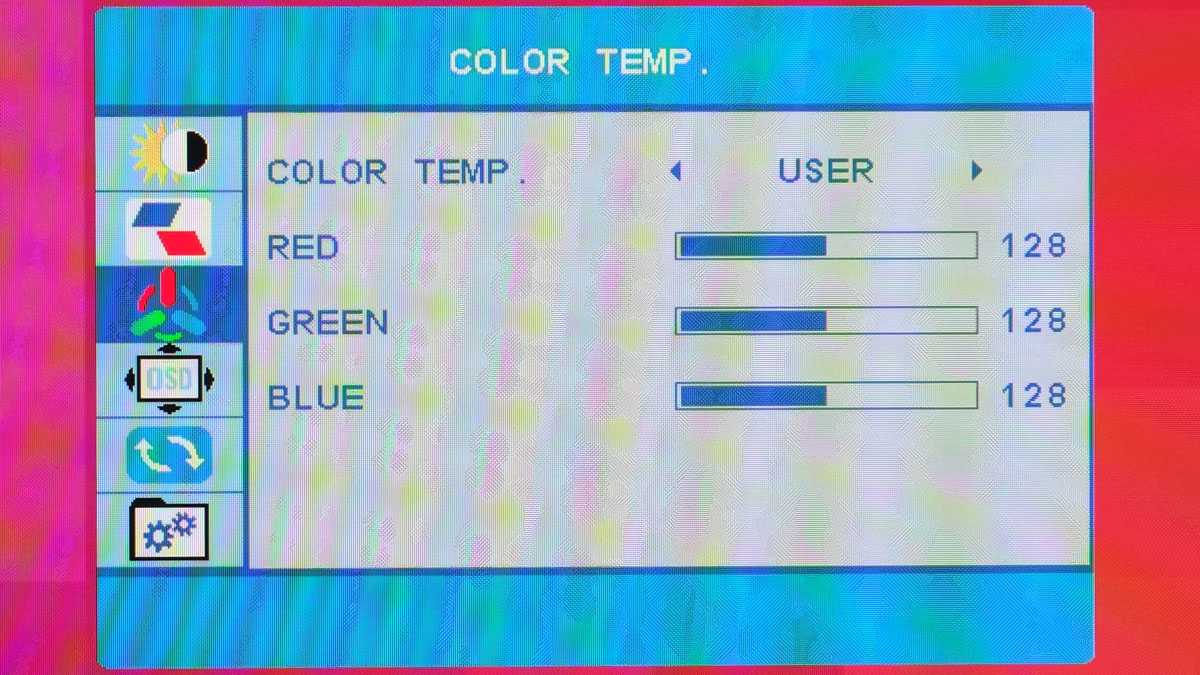
OSD Settings is where some of the greyed out options from the Image menu could be found. This is yet again, the moment where we should start questioning Bezel’s ability to categories their settings. Still, we are thankful for Bezel by adding the positioning options here – cuz the default center of the monitor OSD sucks.
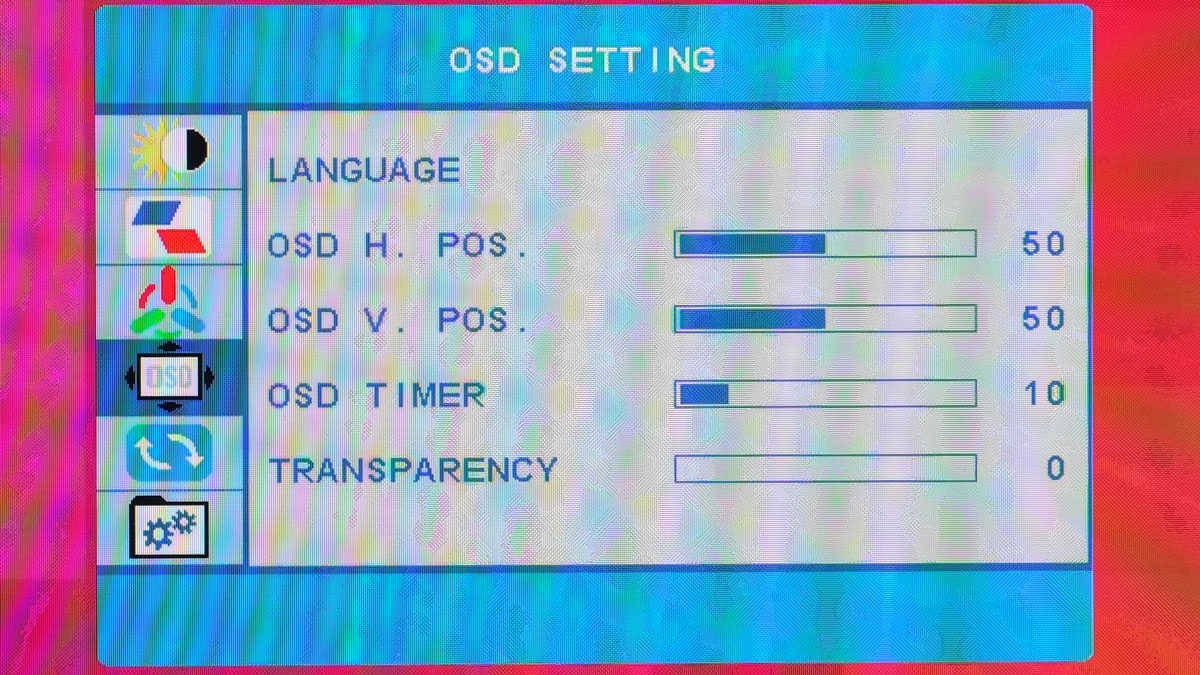
The Reset menu on the other hand is also self explanatory but… Surprise! This is where the MPRT/strobing, HDR and Gamma options could also be found. As for Gamma, we have 1.8, 2.0, 2.2, 2.4 and 2.6 levels. Are these accurate? Read more on the review.
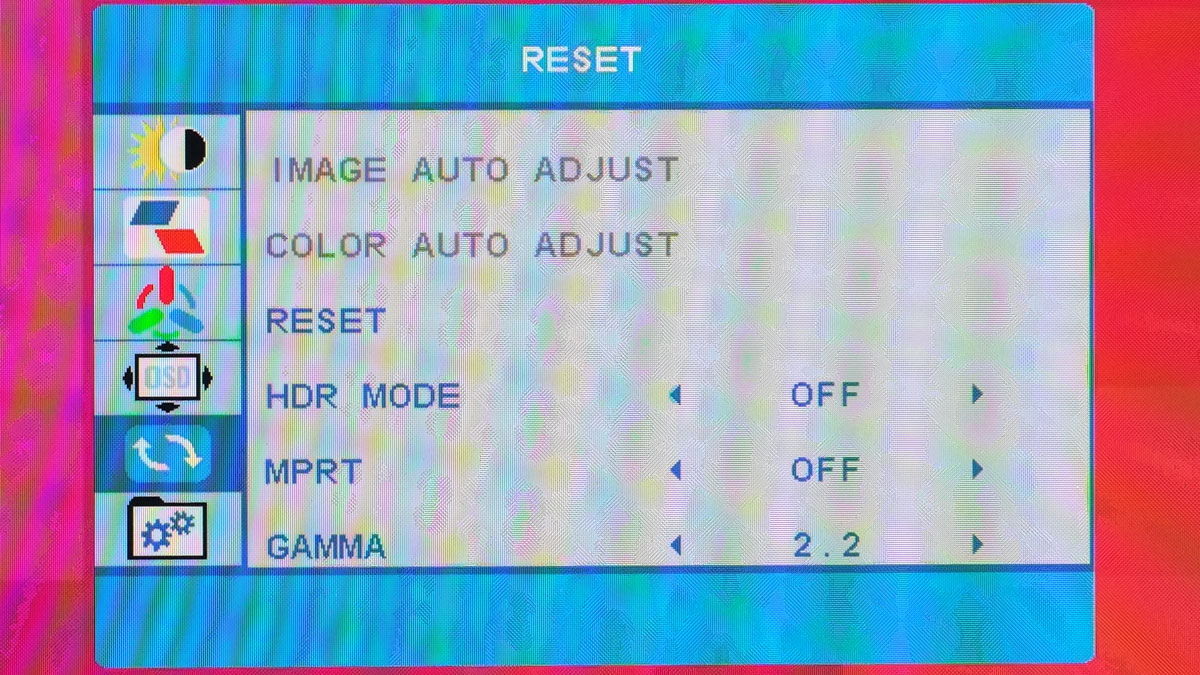
Misc is not really miscellaneous. Just a bunch of IMPORTANT settings presented like a smorgasbord. That includes AMD FreeSync, overdrive and saturation.
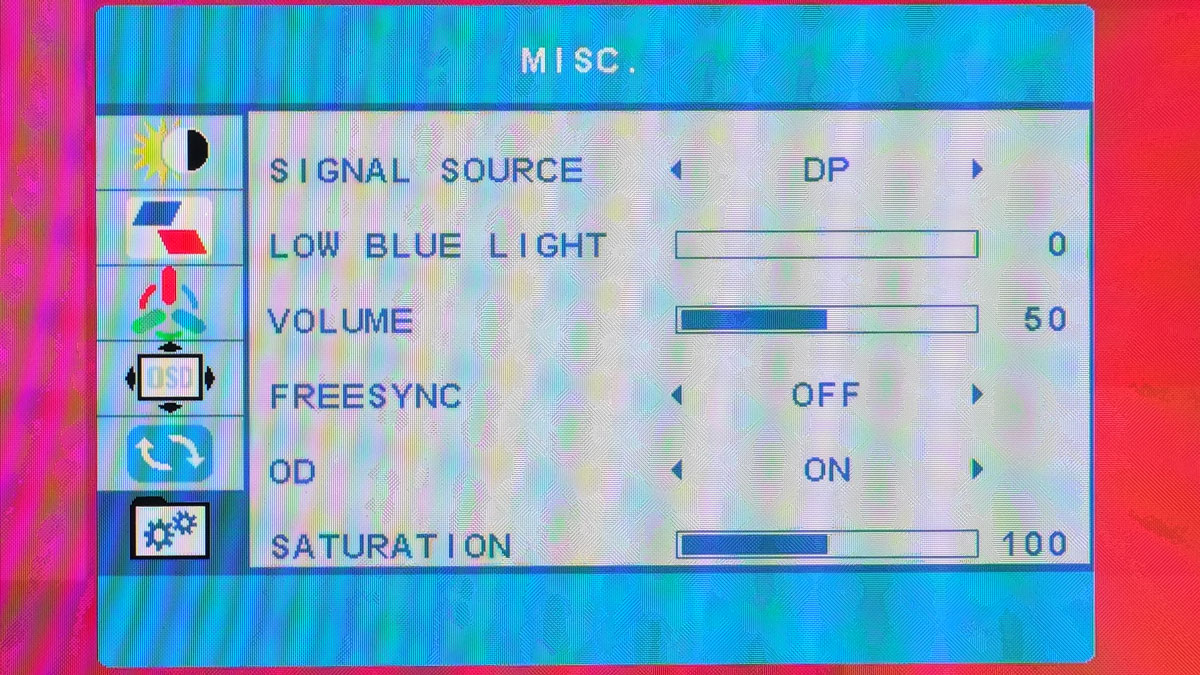
I tried to love this OSD due to its abundant amount of options but it is presented rather disappointing.
Test Setup and Methodology
Our test setup relies on the Blur Busters TestUFO Motion Tests and the Data Color Spyder5ELITE Display Calibration System. The cameras used throughout the review for the motion artifact and high speed assessments are the Fujifilm XE-1 and the Nikon 1 J1.
| Test System Specifications | |
| CPU | AMD Ryzen 5 3600 |
| Motherboard | ASUS ROG STRIX B550-I Gaming |
| Cooler | AMD Wraith Stealth |
| Memory | ADATA Premier 2666MHz 16GB |
| GPU | Palit GTX 1050 Ti StormX 4GB |
| Storage | Crucial BX200 480GB |
| Case | Mechanical Library JXK-K3 |
| PSU | Thermaltake Toughpower GF1 650W |
| Display | ASUS VP249QGR |
| OS | Microsoft Windows 10 Pro 64-bit |
Target for calibration is a 2.2 Gamma value, with a White Point at 6500K and a Brightness value set at 120 cd/㎡. Calibrated values are then analyzed with the Spyder5ELITE Display Analysis tool. Do note that Dynamic Contrast Ratio and other extra features built within the OSD are disabled during the tests. The following OSD values are selected for the display calibration.
| OSD Settings | |
| Brightness | 17 |
| Contrast | 50 |
| Saturation | 100 |
| Temperature | User |
| Gamma | 2.2 |
| Preset | Standard |
If you wish to use the calibrated ICC profile taken from our Spyder5ELITE result, just send us a message. You may also read our guide on how to use ICC profiles.
Color Gamut
The Color Gamut test evaluates the color space coverage of the display panel from industry standards such as sRGB and AdobeRGB. Higher percentage is better.
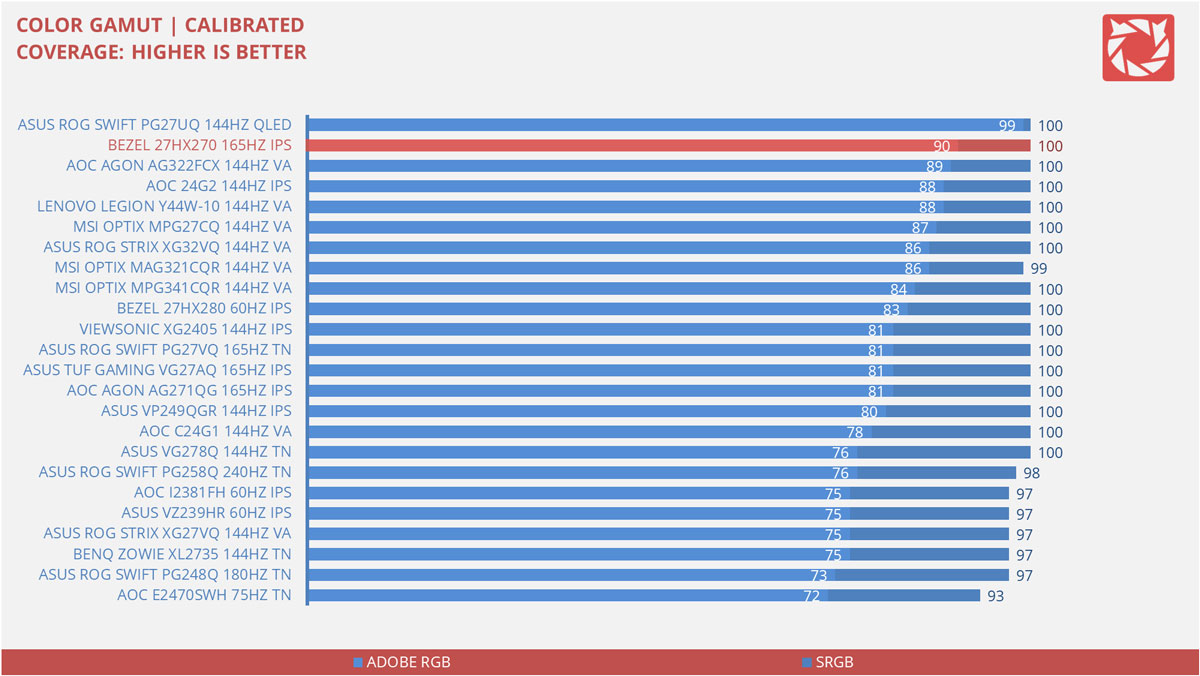
The color space coverage result for AdobeRGB is 90% while a solid 100% is our result for the sRGB color space. DCI-P3 coverage is about 96% though which is awesome.
Tone Response
Tone response is where we check the display panel’s Gamma and presets if there are any. We then compare the results with the industry standard Gamma level at 2.2. Closer to this value is better.
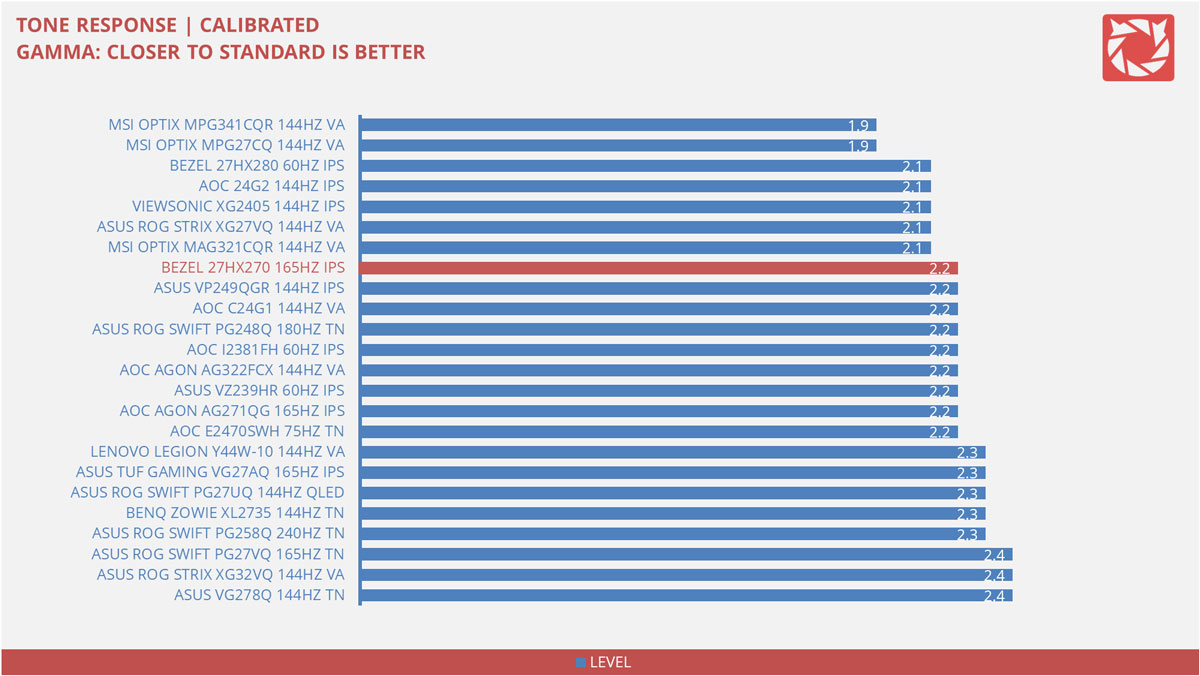
Tone response is spot on for all the gamma level presets. 1.8 is 1.8 on the chart, 2.0 is 2.0 – so on and so forth. That’s until Gamma 2.6 which is insanely accurate.
Brightness
The test here will shows us an overview on how the display performs at its maximum brightness level. This is measured in nits or candela per square meter (cd/m2). Higher is better.
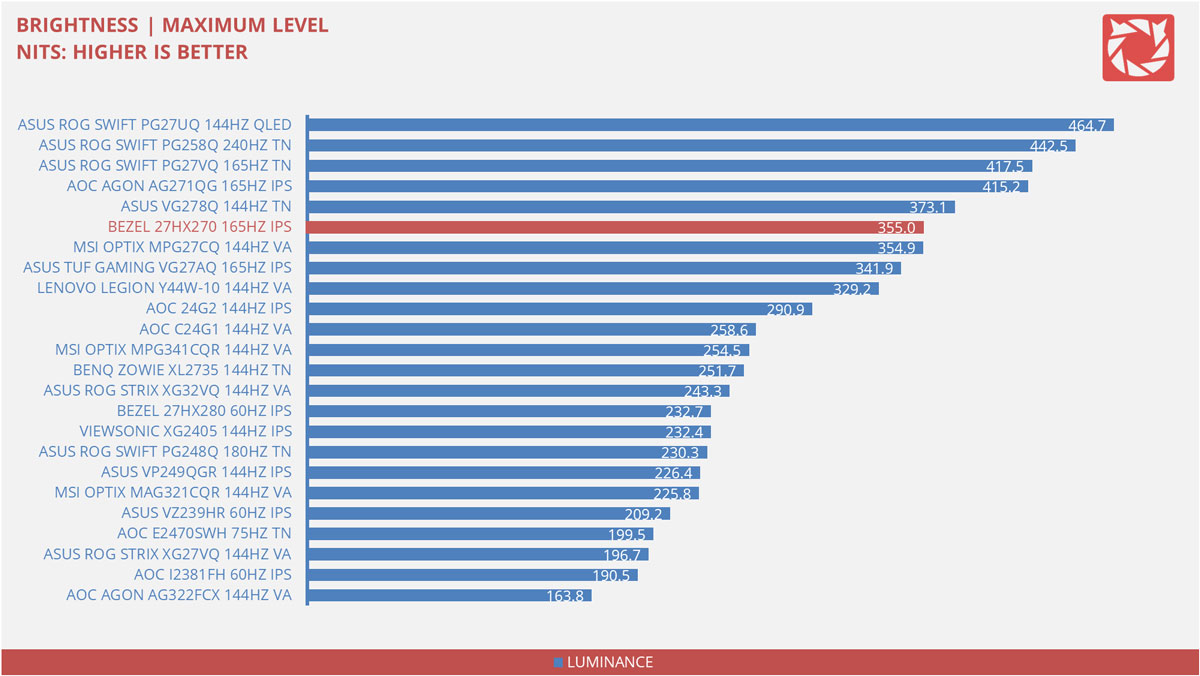
Maximum brightness level is 355 nits which is below the peak brightness required for HDR400 – which is by the way bollocks. This is not a bad output though since it is 5 nits higher than what is specified by Bezel themselves.
Contrast Ratio
Static contrast ratio is also tested. The test here will shows us how the display performs at its maximum contrast level measured in luminance ratio. Higher is better.
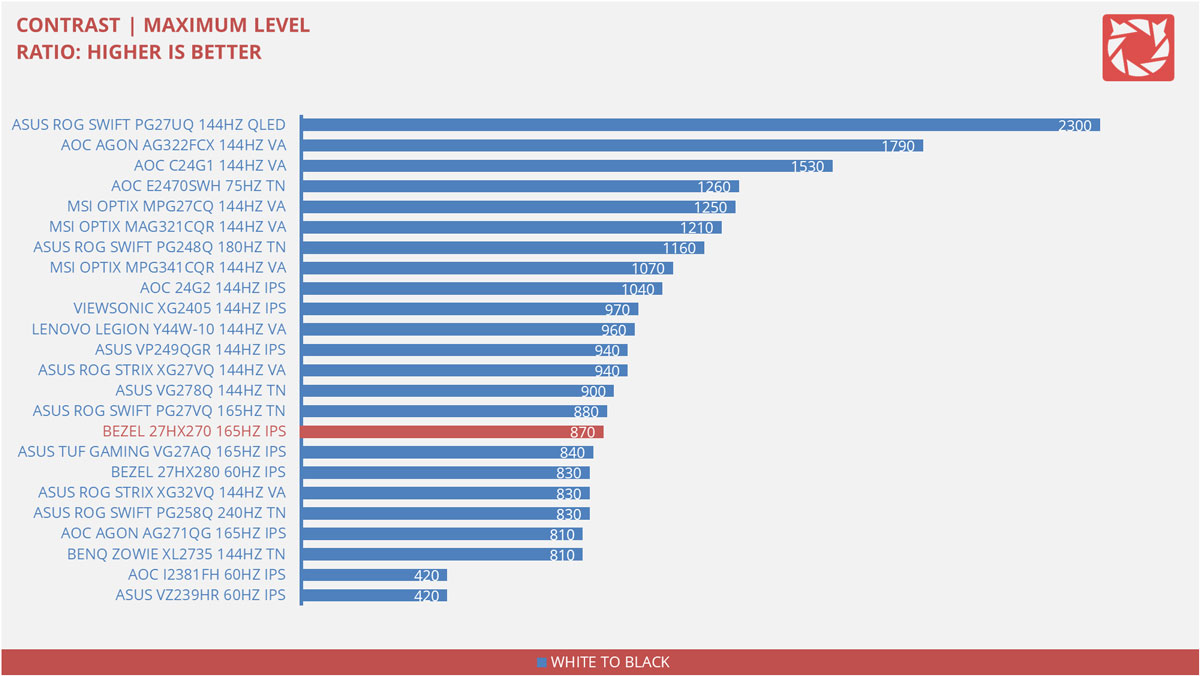
Maximum contrast ratio is about 880:1. Not the best and certainly not the worst either. Quite possibly the only gripe I have with this display.
Screen Uniformity
This test shows us an overview of the display panel’s screen uniformity at maximum brightness level. The closer this value to 0, the better the quality of the panel.
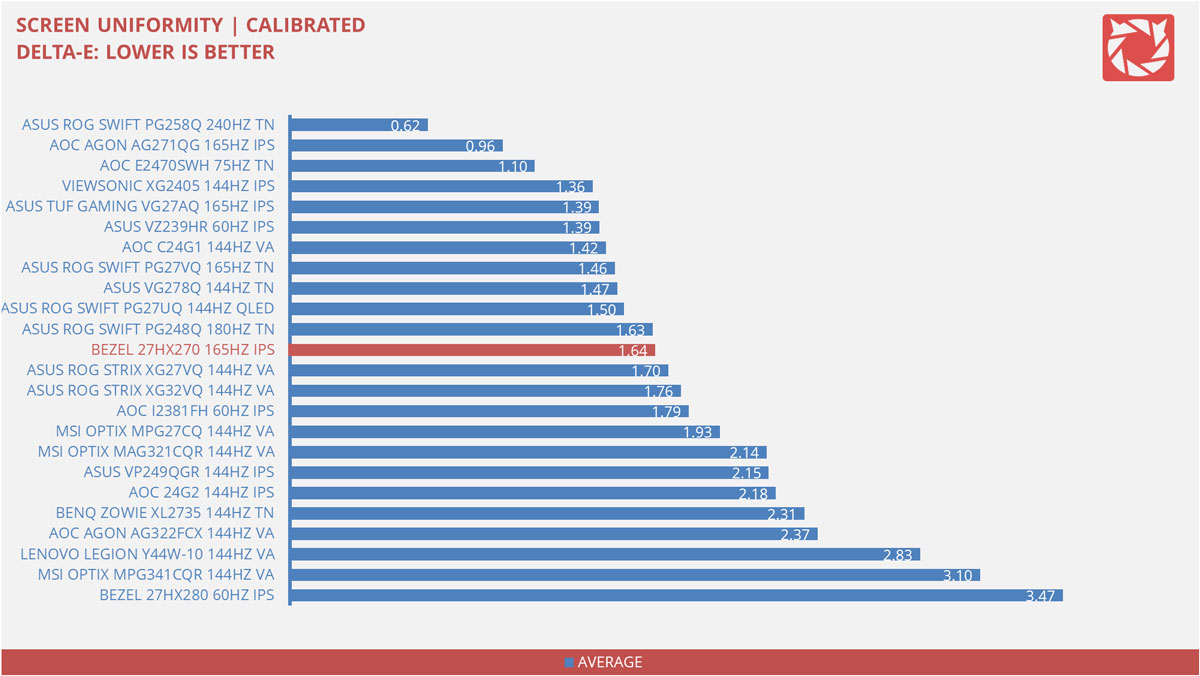
The 27HX270 features a Delta-E average of 1.64 on our screen uniformity test. Upper middle part of the display is the culprit here with the highest deviation.
Color Accuracy
The color accuracy test shows how different basic color hues are reproduced by the display panel. These color tones corresponds with the Datacolor SpyderCheckr. Lower Delta-E values are better.
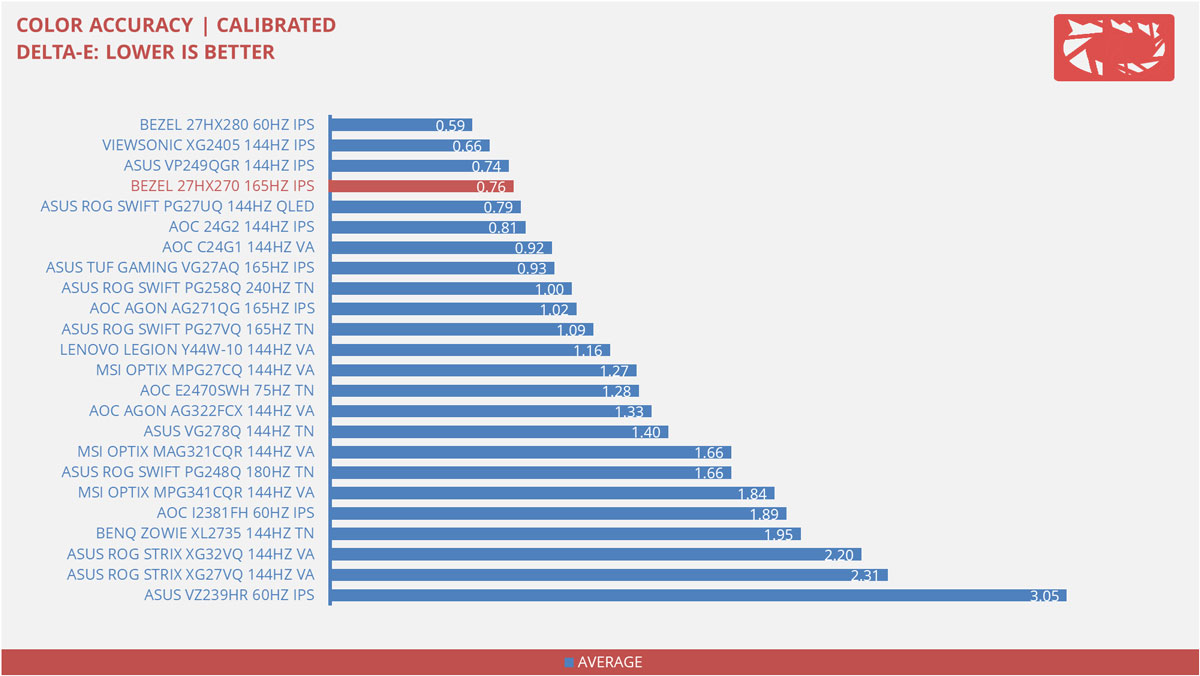
Color accuracy is pretty good with the 27HX270 scoring a Delta-E average of 0.76.
Power Consumption
The power consumption is checked with a power meter. Measurements are taken at maximum brightness and contrast levels.
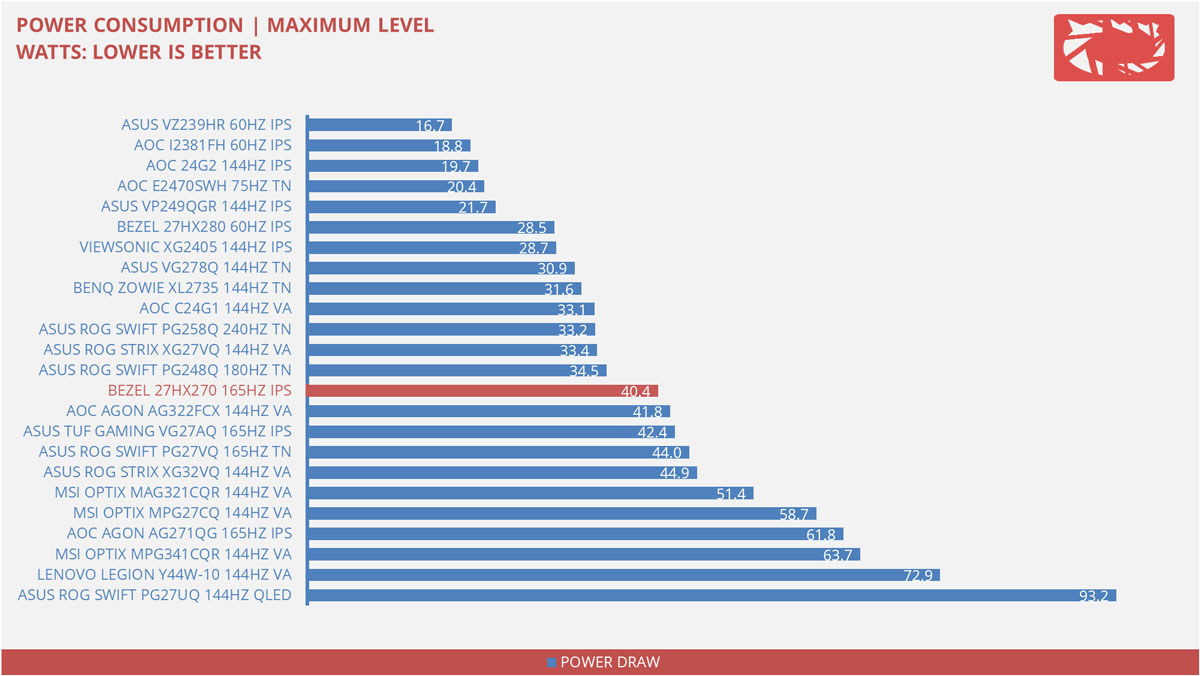
Now power consumption is about 40.4W at maximum brightness and contrast. Power at 120 nits is at 23.7W.
Button to Pixel Input Lag
Our Button to Pixel Input Lag result is the combination of latency from the point of input, processing and display output. To quantify the display panel input lag, we utilized Quake 3 Arena as our main shooter. The game is set at the panel’s native resolution with the FPS locked at 500. We check how much delay in milliseconds it took the monitor to output the signal via a 1200 FPS high-speed camera with ~0.83ms of accuracy.
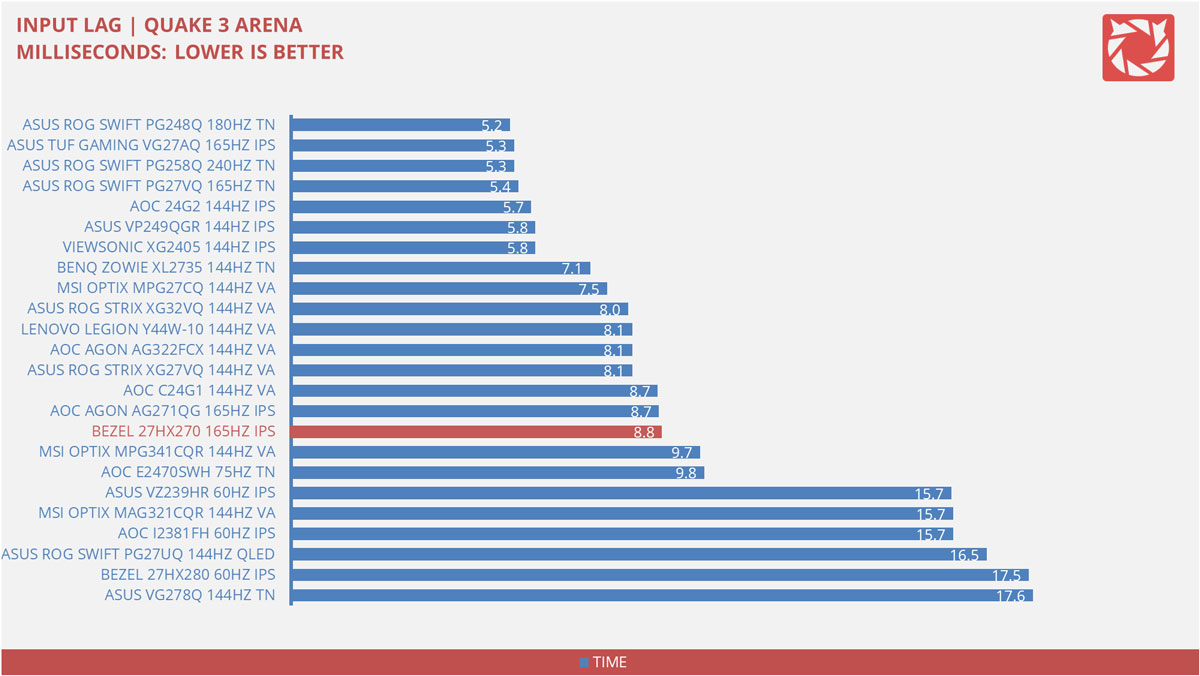
Button to pixel input lag is about 8.8ms which is more than decent for an IPS panel. Thought it would be around 5ms with that added latency from our system over the 3ms GtG.
Motion Clarity: MPRT
Motion Picture Response Time (MPRT) is the numbered approach to demonstrate the level of perceived motion blur on a display. Basically, a lower persistence value indicates less motion blur. Refresh rate and the sampling method plays a major part here whereas a higher refresh rate nominally features better display persistence values.
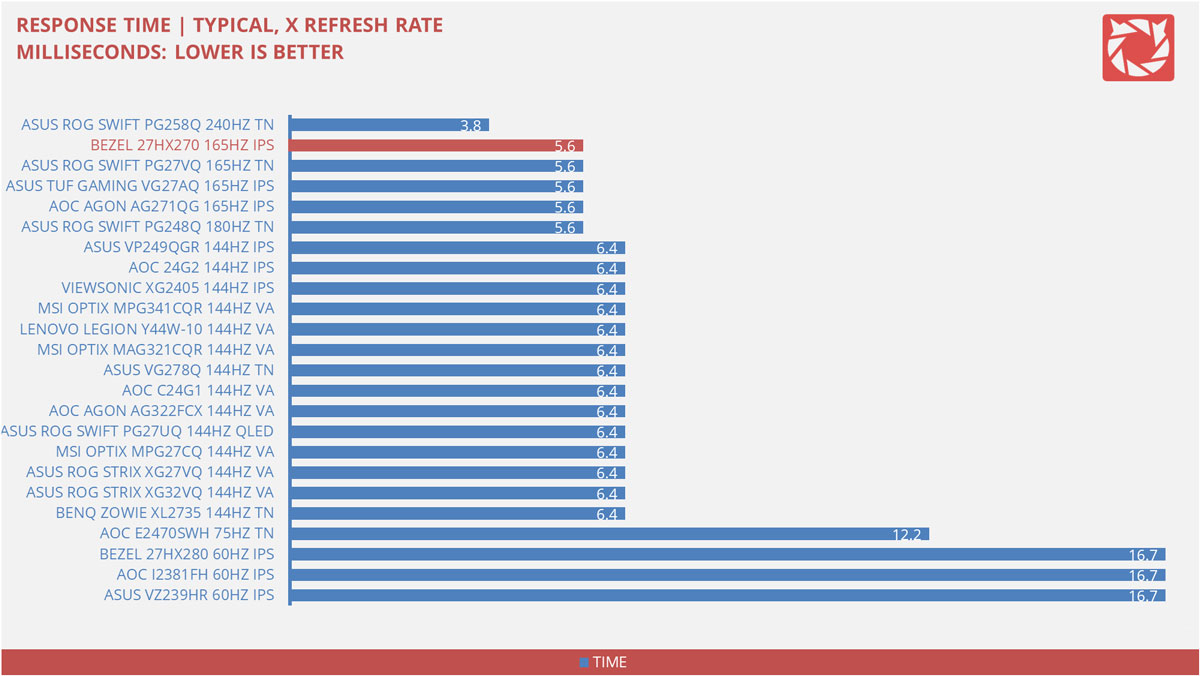
These results are references to check out the theoretical MPRT values of a display. Head over to our Pursuit Camera test for the visual representation of the actual values.
Motion Clarity: Pursuit Camera
Setting up a pursuit camera courtesy of Blur Busters allows us to a great extent, perceive the actual motion clarity of the display. Using such method also allows us to check out motion artifacts including ghosting, inverse ghosting and blurring. This pursuit camera test is a peer-reviewed invention.
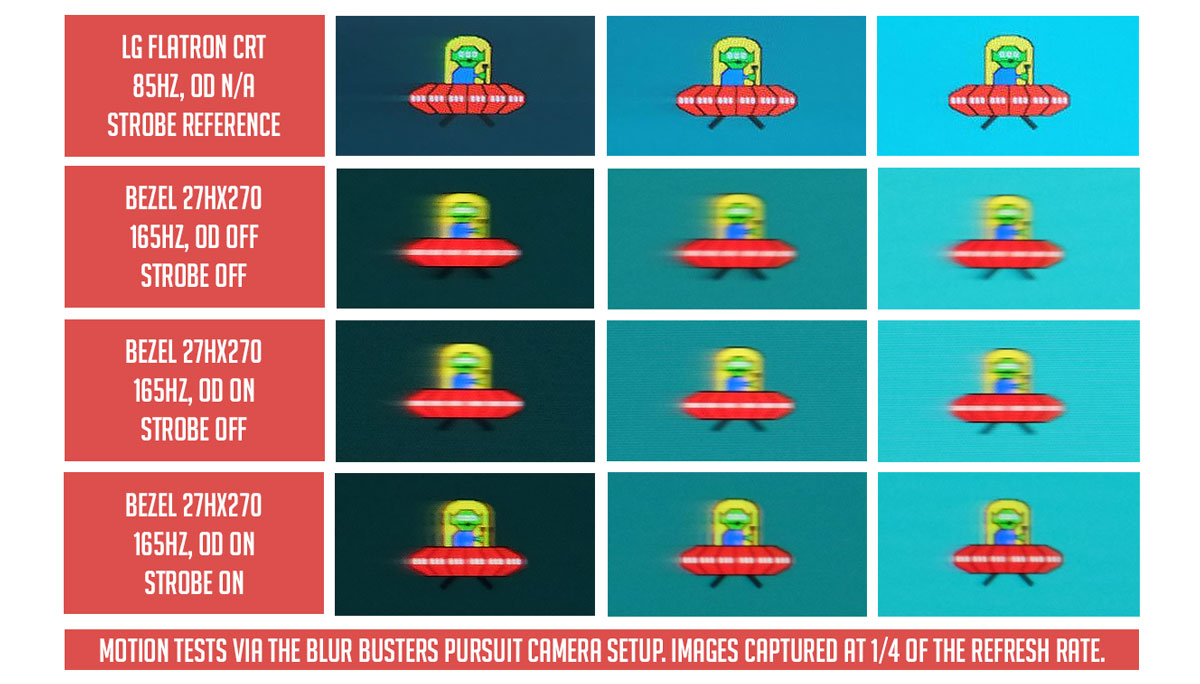
Based on our pursuit camera test, the Bezel 27HX270 showed a decent amount of PWM artifact with strobing turned on (MPRT mode). Ghosting at 165Hz is also manageable.
The MPRT mode comes with 3 settings which each step taking about 10 nits off the brightness. Best set this at low with overdrive turned on.
Back light Bleed
Back light Bleed is the phenomenon where back lighting from a display leaks. This is prevalent with displays where LEDs used to light the panel are situated at the edges of the display. Testing the back light of the display is conducted on a dim room, simulating the recognizable amount of bleed for such scenario.
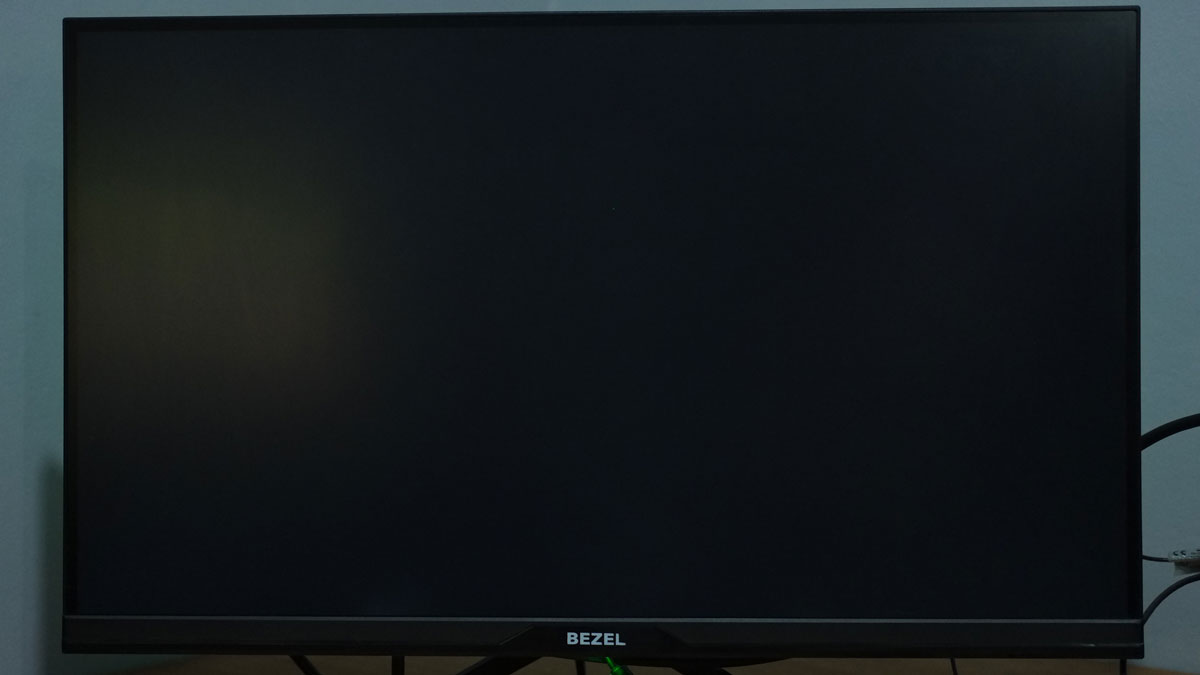
Back-light bleed is not a huge problem with this display. Just a bit of IPS glow at lower areas of the screen.
Viewing Angles
Viewing angles are also tested to check out how the display panel performs at different positions or eye levels. This should be helpful if you are looking for a panel that could be used on multi-monitor setups.
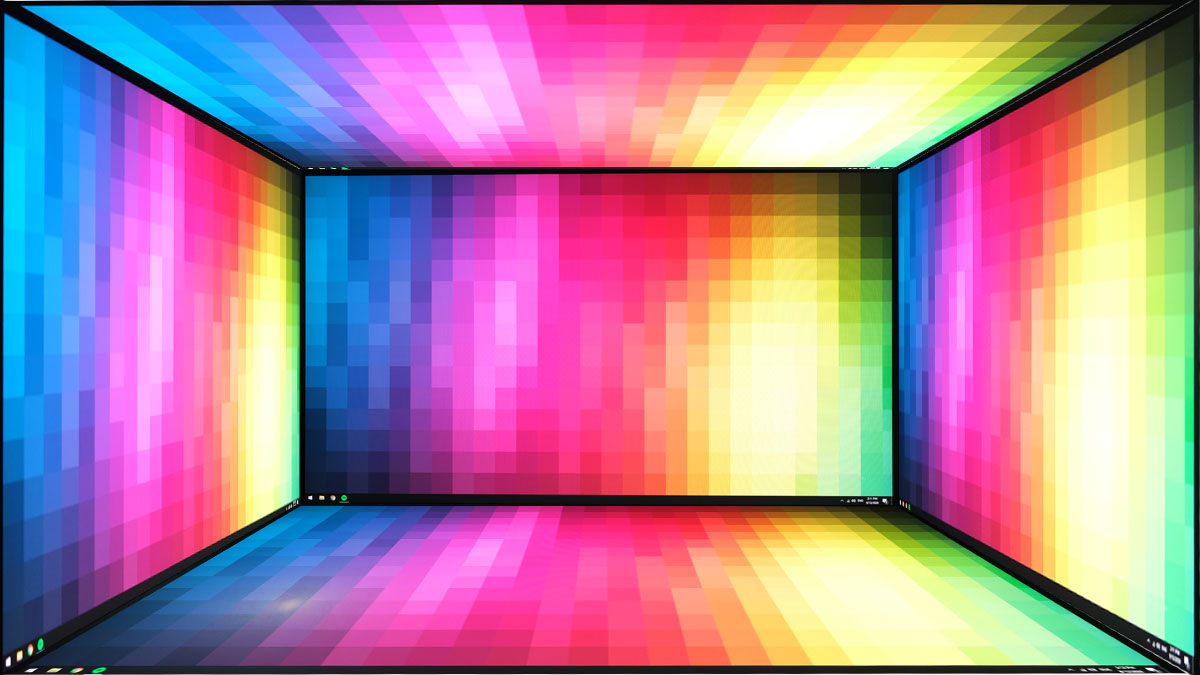
Now color shifting is barely noticeable thanks to the nature of IPS panels.
Frame Skipping
Frame Skipping is the phenomenon where dropped frames and missing refreshes occur due to ineffective refresh rate overclocking. We are are utilizing the Blur Busters Frame Skipping Checker to test if there is any. If your display exhibits such issues, it should be perceptually similar to in-game frame skipping.
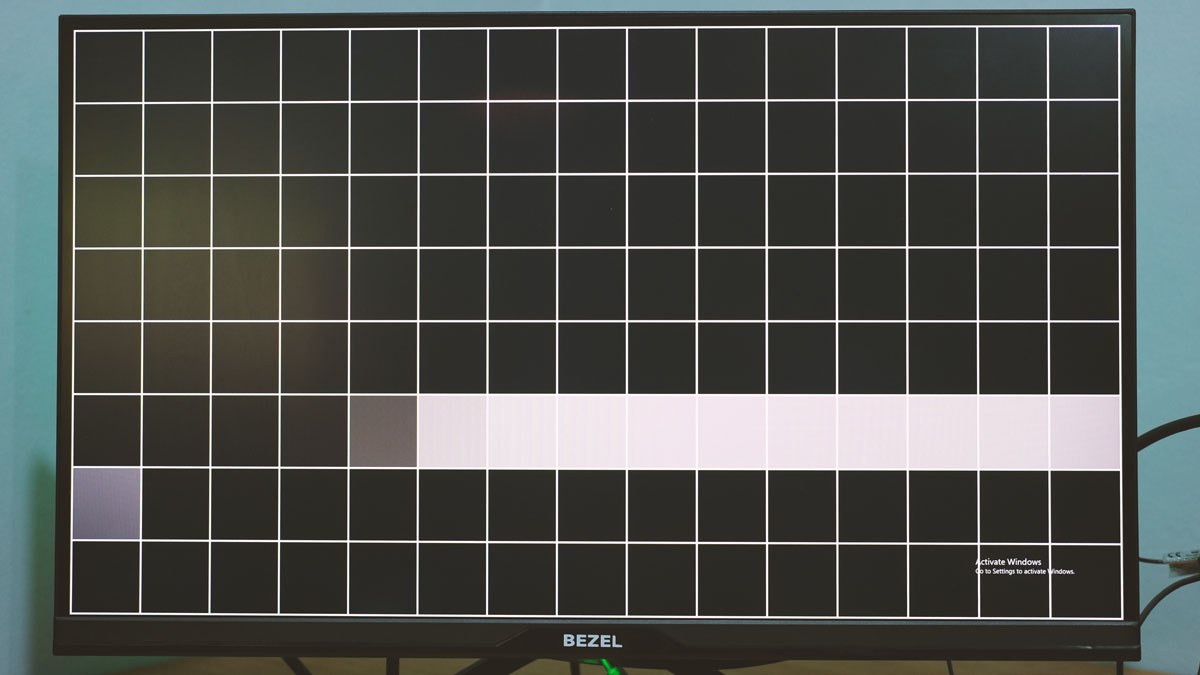
Nothing to worry here when it comes to our frame skipping test. Everything is just smooth at 165Hz.
Software, Lighting and Special Features
On top of its 165Hz refresh rate, the Bezel 27HX270 also supports AMD FreeSync. Note that in order to use the feature with Nvidia GPUs, you have to use a DisplayPort cable. Not a problem though since it is required to run the display at 165Hz. HDMI will only net you a maximum of 144Hz.
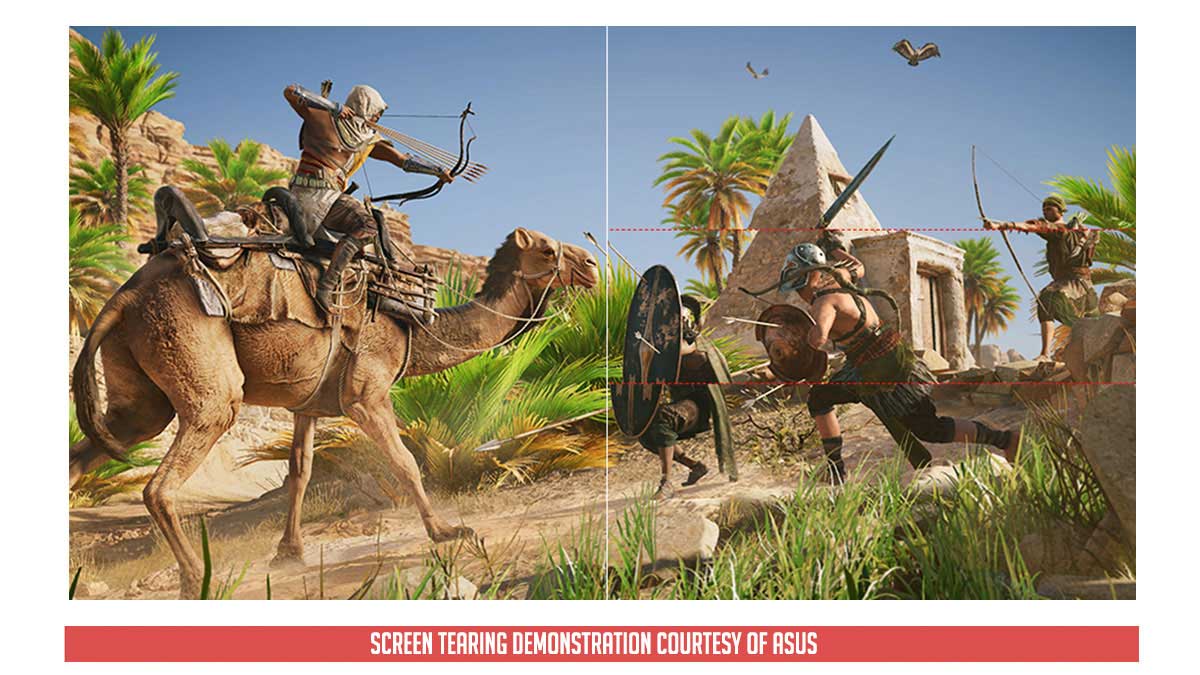
The gaming monitor also comes with back-light strobing in the form of Bezel’s MPRT mode. It is simple and comes in three modes (low, medium, high).
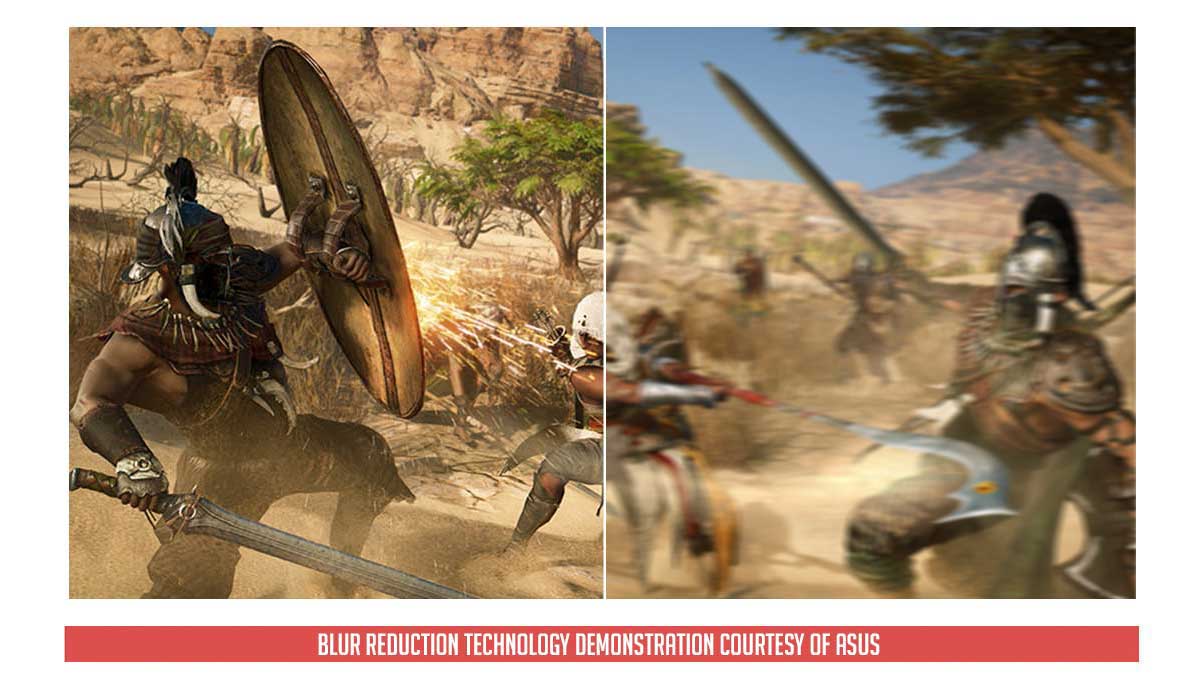
Last but not the least, the 27HX270 also comes with RGB lighting – though not the RGB you expected. Color just rotate and the lighting itself is not that bright. Wont pass as ambient lighting on a dim room. It is just there for the sake of of it.
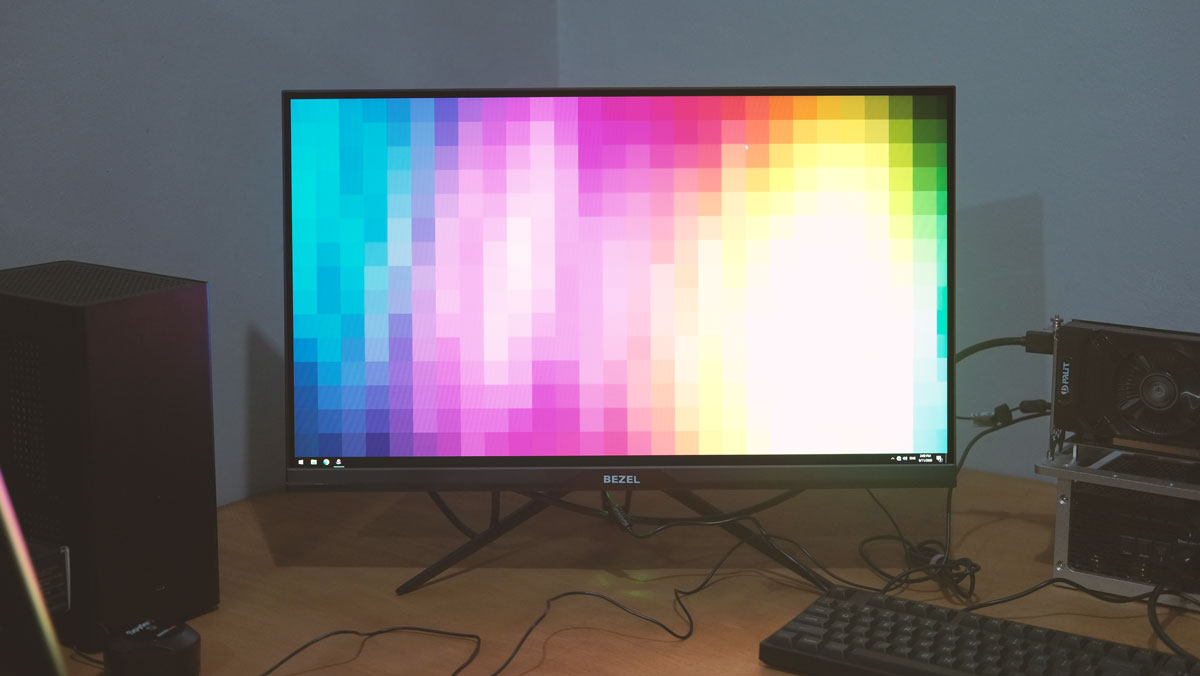
Final Thoughts
The Bezel 27HX270 is one of those gaming displays you probably thought as something too good for its price. It is indeed the case as shown on our review, featuring an excellent performance at its price point of a little over 15,000 Pesos.
Now contrast ratio and screen uniformity aside, the 27HX270 comes with excellent tone response from 1.8 to 2.6 presets. Brightness is also over the specifications – if we’re going to disregard the requirements for the HDR400 certification. Color accuracy is spot on too together with a motion clarity that is appropriate for a 165Hz monitor carrying support for strobing and AMD FreeSync. The extra ergonomic stand is also worthy of a mention.
As for turn offs, I’d say it is the OSD and the overall build quality of the display. Don’t get me wrong, the OSD is awesome as far as its features are concerned but it is just a mess to work with. As for build quality, I would initially say it is more than decent with the aluminum stand and all but the sudden appearance of a single dead pixel worried me a bit. Rest assured, if you bought it directly from Next (Bezel’s distributor), it will be replaced if within the warranty period.
Overall, the expectations I had for the Bezel 27HX270 has been blown away. Performance alone, it is up there competing with models featuring twice or even thrice of its SRP. A really good budget oriented investment if you’ll ask me.
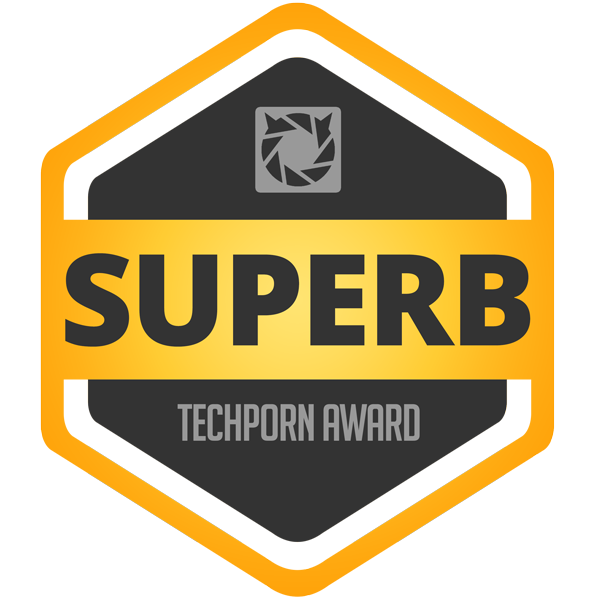

Bezel 27HX270 165Hz
-
Performance - 9/10
9/10
-
Build Quality - 8/10
8/10
-
Features - 9/10
9/10
-
Design - 8.5/10
8.5/10
-
Value - 9.5/10
9.5/10
Summary
The Bezel 27HX270 is a 27″ 1440P panel with a 165Hz refresh rate. It doesn’t stop there as its performance rivals models featuring twice or even thrice of its SRP.
Pros
- Excellent tone response and range
- Color accuracy and coverage
- AMD FreeSync support
- Strobing support
- Excellent ergonomics (plus the extra stand)
- Overall performance for its price
Cons
- OSD is a pain to navigate
- Build quality could be an issue
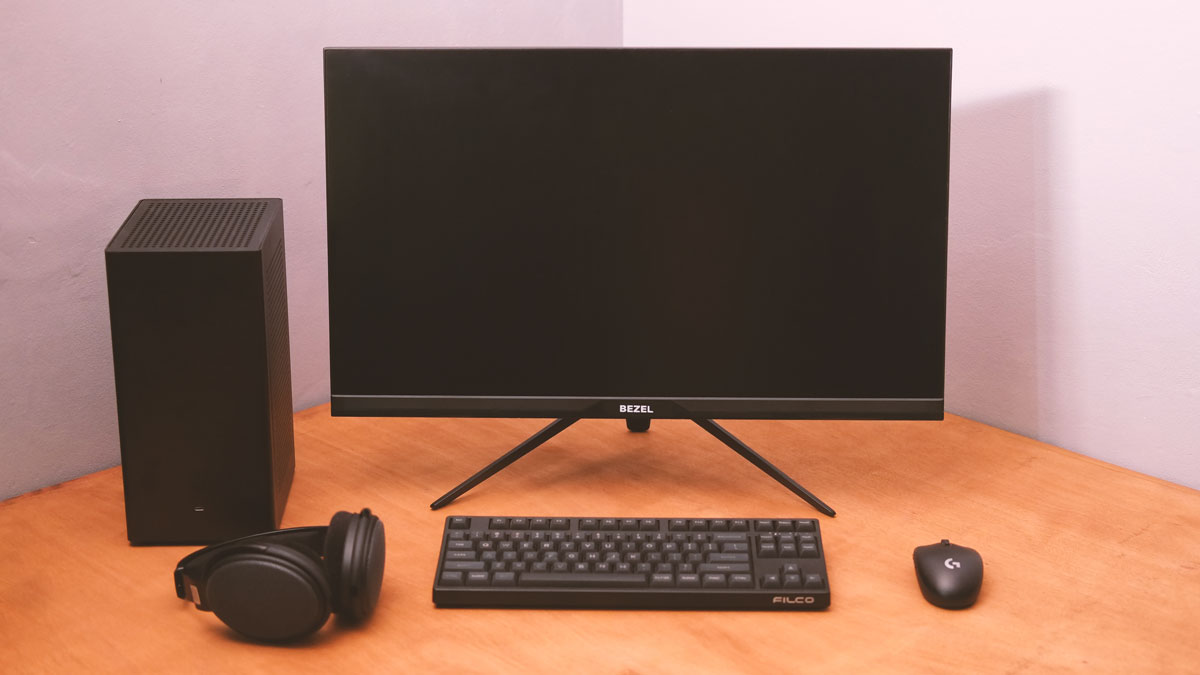
Hello Sir Leo/techporn may I know what’s the best or most recommended 1440p 144hz or above monitor you have reviewed in your website. Thank you
Hi Mark! If you want a jack of all trades but at a price, the ASUS VG27AQ is a rock solid choice.
Hi good day sir, may I know your color, RGB, settings for the monitor? and do you have a link for the icc profile? thanks a lot!